
Project 658 nuclear missile attack submarines
 8 submarines, Project 658, 658M, 701, 658S, 658U (Hotel I-III, 1959-1962)
8 submarines, Project 658, 658M, 701, 658S, 658U (Hotel I-III, 1959-1962)
К-19, К-33/54, К-55, К-40, К-16, К-145, K-149, K-178
Soviet Cold War Subs
Pr.613 Whiskey | Pr.611 Zulu | Pr.615 Quebec | Pr.633 Romeo | Pr.651 Juliet | Pr.641 Foxtrot | Pr.641 buki Tango | Pr.877 KiloPr.627 kit November | Pr.659 Echo I | Pr.675 Echo II | Pr.671 Victor I | Pr.671RT Victor II | Pr.671RTMK Victor III | Pr.670/670M skat Charlie | Pr.705 lira Alfa | Pr.949 antey Oscar | Pr.945 Sierra | Pr.971 bars Akula | Pr.885 graney Yasen | Pr. 545 Laika
Pr.629 Golf | Pr.658 Hotel | Pr.667A Yankee | Pr.667B Murena Delta I | Pr.667D Delta II | Pr.667BDR Kalmar Delta III | Pr.667 BDMR delfin Delta IV | Pr. 941 akula Typhoon | Pr.995 borei Dolgorukiy | Pr.09851 Khabarovsk
Hotel class submarines (Project 658) – were the first Soviet SSBNs and world’s second class, five months after the Georges Washington class. They were not indeed of a design that could be recognised as “classic”, in the straight line of experiments made on the Zulu V class of conventional submarines, and follow-up of the Golf-class, but based on a Foxtrot hull with nuclear reactors. They launched fewer missiles than their US counterparts, as they were located in the sail, not in the hull.
In short, the USN still got a comfortable advance in sea deterrence over the Soviet Union, in quality versus numbers, and the USSR only properly answered by the “Yankee” class from 1966 onwards as Project 667A Navaga and Project 667AU Nalim. The class was split between improved variants recognised by NATO as Hotel I, II and III, all discarded in 1990. The Northern Fleet operated K-16, 19, 33, 40, 55 versed by september 1968 to the Pacific and K145, 149, 178 were by 1963 in the Pacific Fleet. So they spent most of their career here, thanks to their long range. However they were a poor asset, with a bad record of reactor incidents, leaks, fires, sometimes with fatalities, especially for the infamous lead boat K19 “Hiroshima”, an inheritance of the November class powerplants. Counting their patrol days at sea, they spent most of their years in overhauls or maintenance, and the SALT I treaty provided an excuse to have them stripped of missiles and used as communication or “multipurpose submarines”, pending reserve and decommission in the late 1980s.
Development of Project 658
Project 658 (658M) submarines (NATO classification – Hotel class) are Soviet nuclear submarines with ballistic missiles, entering service in 1959. The prototype was based on Project 627 (NATO November class, the first Soviet SSNs). Project 658 (658M) boats retained main design features of Project 627, including their twin nuclear power plant. The main differences were in armament – in addition to torpedoes, the new boats were equipped with D-2 missile systems consisting in R-13 SLBMs (4K50, Western designation SS-N-4 Sark) and D-4 with R-21 SLBMs (4K55, Western designation SS -N-5 Serb). Thus, the Soviet Union created its first nuclear ballistic missile submarine.
The project was developed at TsKB-18 (TsKBMT “Rubin”), its technical specs were developed by chief designer of the project I.B. Mikhailov, construction was carried out by chief (later general) designer S.N. Kovalev.
It all started on August 25, 1956, with the Resolution No. 1601-892 of the Council of Ministers of the USSR and to speed up development, preliminary design was not carried out and the initial technical specifications were simplified. It was envisioned to have missile carriers with surface-launched R-11FM and R-13 missiles. Later, the requirement was changed to use R-11FM missiles, but still for a surfaced launch. TsKB-18 (the future TsKB Rubin) was appointed as lead designer for this development with chief engineer P.Z. Golosovsky.
In 1956, work had been done on ballistic missiles configurations by the appointed chief designer for special weapons, Igor Borisovich Mikhailov, and from February to October 1958, Mikhailov was appointed chief designer of the whole project 658. I. D. Spassky was appointed deputy chief designer. In October 1958, the technical project was completed and signed. Mikhailov was later transferred to work at the State Shipbuilding Committee, so he was replaced at his post by Sergei Nikitich Kovalev as new chief designer, which previously worked at the Central Design Bureau for steam and gas turbine (projects 617 and 643). Main navy observer and representative of the 1st Central Research Institute of Military Shipbuilding was Captain K. I. Martynenko.
Finalization of the design
Project 658 was based on the first Soviet nuclear submarine Project 627 kit (NATO “November”), designed and built by SKB-143 (now SPMBM Malakhit). Main difference was the insertion of a missile compartment from the experimental Project 629 into the hull and sail. All work related to the development of missiles was done by TsKB-16 and by December 1956, the technical design was submitted for approval. Working drawings were completed in the first quarter of 1958 with a final approval of all plans and keel laying of the lead boat on September 17, 1958, on slipway 50 at the Sevmash shipyard in Severodvinsk, near Arkhangelsk (northern fleet).
In March 1958, Project 658M started development as an evolution to carry and fire the new D-4 missile system based on the R-21 missile, with underwater launch. S. N. Kovalev was appointed chief designer and M. S. Faddeev was appointed supervisor from the Navy. In NATO nomenclature it was soon called “Hotel II”. Next, from 1969 to 1970 “K-145” was re-equipped to test the R-29 missilesand received the designation Project 701 (NATO Hotel III), entering service in 1976. See below for more.
Thus, within six years, a large-scale program, unique for the Soviet defense industry successfully provided a series of eight nuclear-powered missile submarines, carrying a total of 24 ballistic missiles with powerful thermonuclear warheads. However, it should be recognized that against the backdrop of the rapid growth of the American nuclear missile submarine fleet, these successes looked rather modest: From December 30, 1950 to May 29, 1964, the US Navy commissioned 20 SSBNs: five George Washington class, five Ethan Allen class, and 10 Lafayette class, with 320 Polaris A-1/A-2 ballistic missiles total, combined on board. Moreover, all American missiles were fit for deep underwater launch mix a maximum range of 2200-2800 km.
Design of the class
Hull and general design

Cutaway. Notes:
1 – Aft 400 mm Torpedo tubes;
2 – Spare 400 mm torpedo room;
3 – Missile siloq;
4 – Pressure compartment;
5 – Bow 400 mm Torpedo tubes;
6 – 533 mm tubes;
7 – Bow torpedo compartment;
8 – Battery (and living) compartment;
9 – CPU (auxiliary power unit room);
10 – Missile compartment;
11 – Auxiliary systems compartment;
12 – Reactor compartment;
13 – Turbine compartment;
14 – Electromechanical compartment;
15 – Auxiliary equipment compartment (living quarters);
16 – Aft torpedo room and compartment.
The Foxtrot (Project 641) hull was retaken as base, as judged far more silent and efficient compared to the Project 611 boats (Zulu class) they replaced. Overall length was 114 m (374 ft)
Max width 9.2 m (30 ft 2 in) and average draft 7.31 to 7.5 m (24 ft)
She displaced 5,000 long tons for the initial design and 5,500 long tons (5,588 t) submerged or the 658M or Hotel II and in volume, metric, normal load some 4030 m3 and in total submerged, fully loaded, 5300 m3;
Project 658 SSBN, like other Soviet nuclear submarines, were of the double-hull type. The robust body was divided into 10 main compartments or bulkhead, able to sustain a massive pressure. The outer hull was made even lighter than on the Novembers, assembled using longitudinal frames, which provided significant savings in steel and a number of technological advantages over transverse ones previously used on domestic submarines.
Already during construction, some boats received a noise-absorbing coating on the outer skin (extrernal hull) made of special rubber. It made it more difficult to track these with the US early 1960s sonar systems operating in active mode, and such coatings were introduced in the Soviet fleet for the first time, and were announced as a world first. However, this first generation coating turned out to be not very durable, peeling off so much that by the early 1970s already, all boats of the 658 project had it peeled off and became the noisest SSBNs in service.
Project 641 hull was alsi very different in shape compared to the Project 627 boats, which had a more rounded profile and ended with a spherical nose, unlike the Foxtrots, which still inherited the same pear style, streamlined hull from the Project 613 boats, derived from the Type XXI design. With the Gold class, these boats ended as the very first and last with such “classic” design. The Project 658 hull was however regarded as one of the best hull design for conventional submarines at the time, fare more silent already compared to the Project 611 (Zulu) boats they replaced. They were tested for years in order to achieve greater efficiency and silence of operation, already without coating.
On the next SSBNs, the Project 667AU Nalim (NATO Yankee), the hull was more rounded, an evolved version of Project 627 hull.
General Appearance
The main caracteristic of the Project 658 design was a massive sail, with the conning tower and bridge forward, all the retractacble periscopes, snorkel, first warning and surface surveillance radars, navigation, communications antennae, etc. The aft part contained the massive ballistic launch tubes, going almost all the way to the keel, and filled with seawater to dampen the propulsion blast when firing (see later). The sonars were located in the upper bow, and lower bow, identified by lighter material coverings than the surrounding black coating. Hull colors were now firmly established as black above the waterline, dark red under, with a fine white line over the waterline belt. Some experts called it the “pacific livery” aas many boats still had a dark gray hull for the Atlantic, or green underbelly for the Black sea fleet. Safety hatches on deck communicating with the pressure hull were signalled by red-white bands. The outlines of the upper bridge’s windows (two rows) were also outlined in white. Large identifiers were painted over the sail.
Powerplant
The centerpiece of the design, the whole propulsion system from the Project 627 (November) was retaken and fit into a Foxtrot hull. It gave the new Project 658 a configuration of two shafts, connected via gearboxes to a pair of GTZA-601 geared steam turbines (DG-400 diesel generators with M-820 diesel engines) not fed by boilers but in that case by VM-A nuclear reactors. The two water-water reactors VM-A of 70 mW each were placed sequentially one after another in the center plane of the ship in the middle part of the hull. They were followed by steam generators and two turbo-gear units 60-D. Two electric “sneak” motors PG-116 with 450 hp each allowed stealth cruise at low speed close to target. They were placed on matresses with shock-absorbing structures and materials to reduce any vibration noise down to zero. There was direct current electrical system (400 Hz, 380 V).
This powerplant allowed a total of 35,000 shp total for a top speed of 18 knots surfaced and 26 submerged, which was excellent despite the different hull shape. This was less than the November class, but the latter were nimbler and lighter for the same output, and were able to reach 30+ knots underwater.
As for range, it was of course unlimited, explaining why these ended in the Pacific.
Working diving depth was 240 m (787 feet) and maximum diving depth 300 m (984 feet), autonomy 50 days. This was less than Project 627 boats, capable of reaching 340 m (1115 feet) but their hull as seen above was more strongly built than any other Soviet submarine to that point.
Armament
The SSBN’s torpedo armament consisted of four bow 533-mm torpedo tubes (ammunition – 16 SET-65, 53-65K and 53-61 torpedoes) and two 400-mm stern small-sized torpedo tubes (6 torpedoes). 400-mm devices, designed for firing anti-submarine torpedoes used for self-defense, provided firing at depths of up to 250 m, and 533 mm could be used at a depth of 100 meters.
Project 658 boats were equipped with the D-2 missile system (R-13 ballistic missiles) at first.
These three ballistic missiles, which wells are located amiship, extending into a retractable hatch. The limited width and substantial dimensions of the launch tubes led to a single row as only alternative. The missiles did not fit in the hull itself and the sail solution was the only practicable. In order to ensure storing and launch safely, due to the earLy self-igniting fuel components at the factory, they were placed in a container factory filled with only the oxidizer AK-27I (a solution of nitrogen tetroxide in concentrated nitric acid). The TG-02 fuel (a mixture of xylidine and triethylamine) was placed separately in a special container outside the main housing and supplied before launch, for about 12 minutes of preparation after surfacing.
Main: 3x R4 (D2 launchers)
 The D-2 missile complexes operated three R-13 ballistic missiles (4K50, Western designation SS-N-4) with surface launch. This was still world’s first specialized ballistic missiles designed for submarines at the time the Polaris program was ongoing, but completed later. Development started by January 11, 1956, initial work carried out by NII-88 under the direction of S.P. Korolev, later transferred to SKB-385, under V.P. Makeev. The R-13 was a fairly crusde missile, long derived from grohnd-launched models going back to the V2. These were single stage rockets with a launch mass
The D-2 missile complexes operated three R-13 ballistic missiles (4K50, Western designation SS-N-4) with surface launch. This was still world’s first specialized ballistic missiles designed for submarines at the time the Polaris program was ongoing, but completed later. Development started by January 11, 1956, initial work carried out by NII-88 under the direction of S.P. Korolev, later transferred to SKB-385, under V.P. Makeev. The R-13 was a fairly crusde missile, long derived from grohnd-launched models going back to the V2. These were single stage rockets with a launch mass
of 13,700 kg for 11.8 meters in lenght with a body diameter of 1.3 meters, stabilizer span of 1.9 meters. They carried a detachable warhead equipped with a powerful thermonuclear charge (1 Mt yeld, mass of 1600 kg) which negated the lack of accuracy. Launch range was 650-700 km, and circular probable deviation equal to 4 km, ensuring still a destruction range aimed at coastal cities as well as naval bases. The engine ran on TG-02 fuel, a mixture of xylidine and triethylamine, and AK-27I oxidizer (a solution of nitrogen tetroxide in concentrated nitric acid). This was self-igniting when combined, but remained a source of increased fire danger so it was later decided to store the rocket in a seawater-fill silo, after it was by an oxidizer.
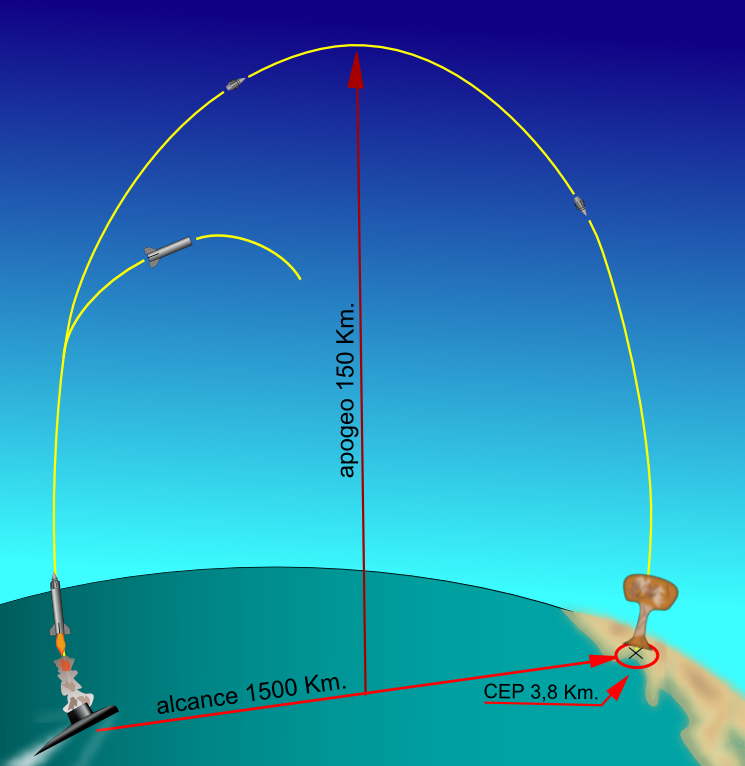
Diagram showing the range of the R-13
Later, the boats were upgraded wth the R-21 and then R-21M (see upgrades).
R-21 missiles
This was improved with Project 658M, with three SM-87-1 launchers for the R-21 missiles, D-4 complex providing this underwater launch. This single-stage liquid-propellant rocket weighted 19.7 tons, for 14.2 meters in height, a body diameter of 1.3 meters. The warhead was essentially the same, 1200 kg, 1 Mt but with a douybled range to range of 1400 km with an accuracy of 2.8 km.
Procedure
The use of underwater-launched missiles led to the need to create a special “holding system” to allow the submarine to stay at a given depth range when launching. Without it after launch, the submarine would uddently rise up to 16 meters, which would force to dive right after to launch the next missile. Before launch the annular gap between the rocket and the shaft was filled with sea water and to avoid imbalance in buoyancy it was filled from pre-filled special annular gap tanks using the onboard pumping system. After launch the imbalance was compansating by the immediate surge of 15 cubic meters of seawater into a special equalization tank. Launches were performed from a depth of 40-60 meters (counting from the bottom of the missile) at arouund 2-4 knots. Total pre-launch preparations went up to 30 minutes with a firing time of all three under 10 minutes.
Position was ensured by the Sigma-658 Navigation system, tracking the course, roll and pitch angles and calculating the ideal speed, providing continuous calculation of coordinates with corrections. During the pre-launch preparation, the data went to the Stavropol-1 and Izumrud-1 computers, calculated corrections for the rotation of the Earth and the pointing angles of the on-board gyro systems of the missile, relative on 2 axis, and calculated the current distance to the target for a temporary setting for acceleration, issuing data to the missile onboard calculator.
The silos had special shock absorbers, with the tail part installed on a special shock-absorbing launch pad. Pre-launch preparation of the R-21 saw tanks pre-inflated to a pressure of 2.4 atmospheres. Then the shaft was filled with water from annular gap tanks, pressurization going up to 8.5 atmospheres. A massive air pressure was formed between the tail and the launch, enabling a spring effect when released, propelling the enourmous mass to the surface before ignition after the shaft was filled with water, and pressure equalized with surrounding water pressure. The shaft lid was opened, the rocket engine was started at reduced thrust, a cruise mode reached with combustion products entering the “air” bell under the missile, reducing hydraulic shock. With the pressure increasing, the push out of the shaft with yokes mounted on the rocket slid along special guides allowing it to safely leave the shaft. Right after the silo lid closed and holding system filled the surge tank to hold the boat at a given depth after which the silo shaft was drained, next rocket launched.
Torpedo Tubes
The torpedo armament consisted of four bow 533-mm (21-in) torpedo tubes, with sixteen SET-65, 53-65K and 53-61 torpedoes in storage, and two 400-mm (16-in) stern small-sized torpedo tubes (6 torpedoes). The 400 mm devices were strict anti-submarine torpedoes usable in self-defense against a shadowing, trailing enemy submarine of detected in wartime, and could fire at depths of up to 250 m (820 ft), whereas the general purpose 533 mm could be used under 100 meters (328 ft).
See on navweaps for more data on these torpedoes;
Sensors
Arktika Sonar:
Hydroacoustic systems included the Arktika hydroacoustic station and later replaced by the Arktika-M on the Hotel II. The later was the first domestic sonar with combined reflector antenna, providing operation in noise direction finding and distance measurement modes. It had been developed under the leadership of chief designer E.I. Aladyshkin, it had a range in echo direction finding mode of 8 km, and in noise direction finding of 1 to 18 km.
Other systems:
Systems aboard included the BIUS general management system, the main detection radar RLK-101 “Albatross” (NATO Snoop Tray), the main bow sonar “Arktika-M”, the MG-10 ShPS trailing sonar, the “Pluton” mine detector, “Yacht” underwater communication system, and for Electronic warfare the “Roll-up” (Quad Loop D/F) RTR and “Van” (Stop Light) systems, decoys GPD MG-14, MG-24, MG-34.
As seen above there was a Navigation complex “Sigma-658”, a radio sextant (Code Eye), ARP-53 direction finder, HF and VHF radio stations (“Iskra-1”, “Tantal”, “Oniks-P”, “Graphite-1”) and DV radio receiver “Depth”, State identification radar “Nichrom-M”.
Decoys:
To break away from a bad encounter, these boats had MG-14 hydroacoustic countermeasures, fired from torpedo tubes.
In 1967, the MG-14 was replaced by the more advanced 7 kg self-propelled acoustic jammer MG-24 usable under 30-40 m with continuous bubbling for 30 minutes. The MG-24 was fired through a special VIPS device. In 1967 also the the drifting small-sized combined decoy MG-34 intended for use at depths from 30 to 200 m and also fired through the VIPS entered service.
As for other equipments, The ship received an all-latitude navigation complex “Sigma” with astrocorrector.
⚙ specifications Hotel II (658M) |
|
| Displacement | 5,500 long tons (5,588 t) submerged |
| Dimensions | 114 x 9.2 x 7.31m (374 ft x 30 ft 2 in x 24 ft) |
| Propulsion | 2 shafts pressurized water reactors, see notes |
| Speed | 18 knots surfaced, 26 knots submerged |
| Range | Unlimited |
| Armament | D-4 missile system, 3× R-21 (SS-N-5 Serb), 4 fwd 21-in TTs |
| Sensors | See notes |
| Max test depth | 300 m |
| Crew | 104 |
Variants & Modifications
In 1963, K-19 and in 1964, K-33, then in 1966, K-149 and at last in 1968, K-40, K-55, K-178, as well as in 1971 K-16 were all converted in turn to under Project 658M (Hotel II) replacing their R-13 SLBM for R-21 SLBM (4K55) as well as a new “Pluton” sonar while their displacement increased to 4030 tons surfaced and more than 5000 tons submerged for a 7.30m draught.
In 1976 K-145 was transformed under under Project 701 (see below)
All 658M swapped their missiles for R-21M SLBM in the late 1970s.
In 1979 K-19 was mdified as a communication submerine under Project 658S and in 1983 this was the turn for K-55 and in 1984 K-178 under Project 658U. In 1985 K-16 also lost her missiles under SALT agreement but was fitted with a wake detector for tests. By that time all 1st gen SSBNs were replaced by newer DELTA class boats.
Project 658 HOTEL I

Essentially the type described above. It was equipped with the missile compartment previously used on the Golf class SSBs but small horizontal hydroplanes were added for extra maneuverability. More reliable electro-hydraulic command control surfaces were fitted, using main ballast low pressure air to reduce noise and thus, detection.
All eight submarines built were of this type, all setup to operate and fire, surfaced, three R-13 missiles in the D-2 launch system behind the sail. This early type had 12 minutes surfaced to launch a single missile from international waters, during which detection was likely. None was ever operational in that guide as they were quickly revised. First planned was K-19 (laid down on 17 October 1958, completed in November 1960).
The first two submarines of Project 658 joined the Northern Fleet and in 1960-1961. were sent to the Zapadnaya Litsa base, where, together with torpedo nuclear submarines of Project 627A, they formed a brigade. In January 1962, on the basis of this brigade, the 1st submarine flotilla was deployed, consisting of two divisions – the 3rd (Project 627A boats) and the 31st (Project 658 SSBN). In 1964, the division of nuclear missile carriers was transferred to Gadzhievo (Sayda Bay, Yagelnaya base) as part of the 12th squadron, which was later transformed into the 3rd flotilla of nuclear submarines.
The appearance of the first nuclear-powered missile carriers in the Soviet fleet, of course, did not go unnoticed by American naval intelligence. Soon the new ships were given the NATO code name Hotel.
Project 658M HOTEL II

The shortcomings of the class on paper led to the adoption of a new launching system, a decision taken even before the first keel was laid down, by March 1958. The sail ontainers were modified to carry the improved D-4 launch system. The latter allowed at least to conduct submerged missile launches, something that made this class fvar more potent, especially compared to the Golf class, noisy and forced to fire surfaced. This modified SSBN was called 658M (NATO Hotel II) under chief designer S.N. Kovalev. Structural changes were needed and notably to modify the wells for havung them filled before launch in the gap between the launch tube and missile, finding a way to vent out combustion gasses. Still, this fiuring was done at a submerged depth of 16 m only (52 feet), leaving a water panache of seawater that could be picked up by radar. The preparation time seems to be the same, circa 12 minutes per launch, so almost three quarter of an hour for three launches.
The program was completed on December 30, 1963 and until 1967 all submarines but K-145 were re-equipped with the D-4 system. The latter indeed was re-equipped with R-29 missiles and converted (see below).
Project 701 HOTEL III

Project 701 only counted a single boat, “K-145” and its modernization was carried out during scheduled maintenance, starting on December 1965.
From 1969 to 1970 “K-145” was taken in drydock for a complete modernization for experimental purposes. She was to be the testbed for launching the brand new R-29 ballistic missile. After conversion under the designation Project 701 she became 130 m in overall lenght, with a displacement rising to 5,500 Tons surfaced, 6,400 Tons submerged, top speed reduced to 18 knots surfaced, 22 knots submerged and four launching racks for R-29 missiles in a new compartment behind the sail as previous boats.
In 1976 the K-145, the sole and only Hotel III was commissioned and entered service.
The R-29 Vysota (NATO SS-N-8 Mod 1 “sawfly”) was tested to the benefit of its designated carrier, the Project 667B Murena (Delta I).
Quick specs R-29: 2-stage 32,800 kg 13.20 x 1.80 x 1.80 m wsp, warhead 1,100 kg yeld 800 kt, range 7,700 km (4,784 miles)
The R29 used azimuthal astrocorrections with accuracy within 1.5 kilometers. The launch was possible both from underwater or surfaced and more importantly, all missiles could be fired in one single salvo underway at 5 knots below 50 meters (164 feet) and in Force 6 sea waves.
She also gained the RLK-101 Albatros radar, the MG-200 Arktika-M and the “Pluton” sonars as well as the Nakat ECM suite and the Alfa-701 CCS.

Initial trials were completed at the Northern Fleet in Olenya Guba, March 25, 1971. Testing of the R-29 was completed in November 1971 and joint testing with the D-9 complex started by December 1971 with the first operational launch on Xmas day while surfaceed in the White Sea through pack ice. The next three tests were also successful however the fifth launch (March 1972) saw an accident in pre-launch pressurization of the tanks, and the first stage were destroyed. It happened under command of Captain Yuri Illarionov, which ordered to surface urgently, cancel pre-launch preparations and open shaft lids. But this was too late to escape explosion of the container, still the external sail structure contained the blast and the pressure hull remained intact. K-145 thus sailed to the Yard for repairs, until August 3, 1972. Joint tests resumed and were completed on November 28, 1972 after thirteen launches. This was a world’s first as two missiles were launched at an intercontinental range in the Pacific Ocean, with an acceptance certificate signed on December 19, 1976.
Project 701 provided a way to upgrade also Project 658M submarines with six 4S-75-1 launchers for R-29 missiles but for budgetary reason, the conversion was never done.
Project 658S

After the SALT-1 treaty was signed in 1977, all missiles were to be removed from Project 658 boats. The first was K-19, converted in 1977-1979 as a Project 658C for testing new submarine radio communication devices.
Project 658U

During the same process of removing missiles, two more Pacific boats, K-55 and K-178, were converted into Project 658U communications ships. The torpedo load was reducedand they received a comprehensive communication suite to relay data across the Pacific. They were maintained in service until the end of the cold war in 1988-1990.
*Hypothetical Project “658T”: The four remaining K-33, K-40, K-16 and K-149, also saw the removal of their missiles but some sources indicate a re-equipment under the 658T project, something denied by the Rubin Central Design Bureau of Mechanical Engineering. These remaining boats were scrapped instead.
Career of the Hotels
When first revealed in 1967, these submarines made the pride of the Soviet Navy, their first ultimate deterrence asset facing the Western block, and the largest and most advanced submersibles ever built in USSR (or Russia). The later launches attracted the press and made headlines, ceremonies linked to K19 however remained secret.
The first two submarines joined the Northern Fleet and in 1960-1961 were sent to the Zapadnaya Litsa base, forming a brigade together with Project 627A submarines, the later protecting the former in dsployments. In January 1962, the 1st submarine flotilla was deployed, consisting of two divisions, 3rd (627A boats) and 31st (Project 658 boats). In 1964 the division was transferred to Gadzhievo (Sayda Bay, Yagelnaya base) as part of the 12th squadron, later transformed into the 3rd flotilla.
The appearance of the first nuclear-powered ballistic missile subs (SSBN) in the Soviet fleet were noticed by US naval intelligence. In 1963 and 1968 K-178 and K-55 were transferred to the Pacific Fleet, where they were assigned to the 45th division of nuclear submarines, based in Kamchatka. After their Hotel II conversion, all were transferred to the Pacific.
However a decade of hard service in the Pacific degraded their performances sharply, starting with their revolutionary coating, that peeled off rapidly. Despite their high noise level and outdated equipment, relatively poor habitability conditions and a number of other shortcomings, the 658M boats were maintained fully combat-ready into the late 1970s. They were sent to Patrol in close proximity to the US West coast and provided a missile cover at all time (subs were rotating per area of operation) under an extremely short flight time, making it difficult to take measures to counter a Soviet missile strike. Habitability conditions remained an issue however and differed from the later SSBNs, much roomier and more automated, meaning less crew. However, each SSBN crew member had his own sleeping place, not one shared, its own personal locker and a roomy mess, and maintenance of provision rooms largely compensated for everyday inconveniences.
 K-19, aka “widowmaker”, aka “hiroshima”
K-19, aka “widowmaker”, aka “hiroshima”
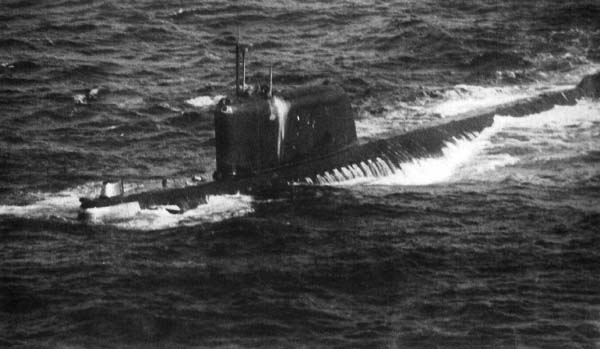
The infamous K-19, immortralized in “K-19:The Widowmaker” movie (2002) was launched October 11, 1959. By July 12, 1960, she was commissioned in the northen fleet and started sea trials the next day. On November 12, 1960, the State Commission signed the acceptance certificate and she started her operational training under N.V. Zateev, first commander. The movie anecdotes, like the bottle not breaking and many accidents and fatalities in completion, were true, and the sub already was seen as “cursed” by superstitious sailors.
While returning to base after participating in the Arctic Circle exercise, and about 70 miles from the Norwegian island of Jan Mayen, the aft reactor powering the starboard steam generator failed. At 4:15, while underwater, both reactors down to 35% power, the watch commander of the remote control group detected a drop in pressure in the primary cooling circuit as per the instrumentation. As it turned out later, the piping was damage during testing alread at overpressure, but the rush to complete the boat left leak detections unadressed.
The accident was inevitable, and the emergency protection was reset. At 4:22, the submarine surfaced due to mounting radaiation levels, and went on on her course while the reactor and port shaft line were operating. 30-40 minutes after the start, gamma ray activity grew to such levels that ventilation seemed soon unsufficient. At 7:00 an attempt was made to emergency flush the reactor through the air vent line, but the hose was torn off. Another attempt using the main circulation pump led to another failure. At 8:45, after heroic efforts inside the confinement cell, to weld the pipeline to the air vent by an emergency party, the emergency reactor spillage ceased, at least for a time. As a result cold water being used in an abnormal procedure, the core was destroyed and gamma radiation increased sharply. More errors followed like a depressurization and water removal by the bilge pump in compartment 10, so radiation sharply worsened, whereras contamination spread throughout the ship. Meanwhile a destress call was made, and the closests, S-270 was eventually detected to the rescue, commander Zateev made a decision to evacuate the crew, fortunately helped by very calm seas and bright weather.

A day after the accident at 4:00, all personnel had been transferred to S-270, and then to the S-159, and later the remainder to approaching destroyers. In case of any foreign ship appearing, K-19 was ordered to be scuttled (unlike in the movie for dramatic effect, no US ship was ever present). She was towed to base and replacement of the damage core and decontamonation procedures commenced, but the incident, which led to the court of enquiry, saw eight died from July 10 to July 23, 1961 due to radiation, with many of the crew suffering froml various effects for the remainder of their lives and by August 1, 1970, captain Anatoly Kozyrev died and many later had several surgical interventions and operations, notably massive transfusions.
The incident and its consequences were immediately classified and remained top secret for thirty years until the collapse of the Soviet Union, after which publications started to appear notably in 1994 in Los The Angeles Times.
After being deactivated, in Severodvinsk by mid-December it was decided to overhaul K-19 from January 30, 1962, to Project 658M, until December 1963, after which she passed all state tests with a new crew. She passed all her weapons tests repeatedly with an “excellent” rating.
On November 15, 1969 while in the Barents Sea as she maneuvered shaply from 60 to 90 meters, she collided with shadown USS Gato (Lose Angeles class), severly damaging her bow, but she was still able to return to base surfaced. There was no casulatly but a lot of damage, a months of repairs. 1970-71 were spent without incident.
However there was a fatal Fire on February 24, 1972: A few days earlier a steering system pipeline burst in the ninth compartment and by February 24, oil leaked at the bottom of the compartment, then ignited from a hot electrical appliance, the high-pressure air line burst, oxygen began to flow into the compartment, feeding the flames. The fire spread to the adjacent bow compartment and control panel for the power plant, with captain-lieutenant Viktor Milovanov and senior lieutenant Sergei Yarchuk inside, shutting down both poweplants. Yarchuk died and Milovanov finished his work alone and survived using his gas mask but lost consciousness, and was pulled into the central compartment by the turbine operator.
In the seventh compartment, midshipman Alexander Novichkov distributed gas masks and died. The 12 sleeping in the tenth compartment were caught by surprise and never had time to take a gas mask, they all died from suffocation.
B. A. Polyakov, most senior in rank, took command isolating the bruning compartment from the rest of the boat a d later ordered tge boat to surface and launched a distress call.
It was answered by the cargo ship Angarles two days later and the cruiser “Alexander Nevsky” with a reserve crew and specialists from the fleet departments under Vice Admiral L.G. Garkusha.
Rescue efforts were complicated by an ongoing storm. Sje was towed to port, but the incident costs 30 sailors. 28 died during the fire, one was washed away by a wave during transfer evacuation, and captain 2nd rank Tkachev was fatally injured on the floating base “Magomet Gadzhiev” due to the storm.
The years 1973-78 were without incidents. In 1979, K-19 was now considered obsolete and after SALT agreements, was disarmed and later converted into a communications sub, Project 658C (KS-19). She was decommissioned on April 19, 1990, renamed BS-19 in 1992 and despite effort of veteran submariners she was not preserved and instead, sent for recucluing disposal in 2003 at the Nerpa plant.
Still, despite her horrid reputation, the lead boat of the Hotel class covered 332,396 miles in 20,223 running hours, making six long cruises for 310 days total and launched 22 ballistic missiles, 60 torpedoes.
 K-33
K-33

K-33 (from 1983: K-54) was laid down on February 9, 1959, launched 08/06/1960, commissioned on December 24, 1960 and in 1961, completed 6 cruises over 9,611 miles underwater, 2,235 miles surfaced. From 10.25.1962 to 12.29.1964, she was converted as Project 658M boat at Zvezdochka Shipyard, Severodvinsk. She received a new core in 1965 and by 1967, carried out made the first launch of three ballistic missiles in the Soviet Navy. In 1968, she had another core change. From December 30, 1964 to January 15, 1969, she had only 49-day of combat patrols, and from April 1, 1969 to April 1, 1971, she was in overhaul, with another reactor core change. 1972-74 saw her making three cruises over 150 days but on 05/07 to 06/17/1976 she had her reactor cores recharged and from 03/09/1978 to 06/30/1983 she was overhauled, then converted as Project 658-T multi-purpose submarine. In 1987 she was transferred to category 2 reserve and discarded, stricken and BU from 09/16/1987.
 K-55
K-55

K-55 was laid down on August 5, 1959, launched 09/18/1960, commissioned on December 27, 1960. Between 06/23 and 07/13/1961 she made a 20-day underwater trip and completed 6 patrols over 12,524 miles under water, 1,117 miles surfaced, then an overhaul from 10.1964 to 12.1966, conversion as Project 658M. She was sent to the Pacific Fleet from June 25, to September 6, 1968, in secret, over 1,735 miles in 128 hours. In 1969-70 she made two cruises over 99 days. She was disarmed, overhauled and converted in 1977-79 as Project 658-T multi-purpose submarine. From 10.1981 to 04.25.1983, she was converted as a Project 658-U boat and had her reactor core changed. She acted as com sub in 1986 but due to issues woth the power plant she was placed in reserve, stricken in 1989 and BU.
 K-40
K-40
K-40 was laid down on December 6, 1959, launched 06/18/1961, commissioned on December 27, 1961. She made from 1963-66 two combat patrols over 77 days and took part in the “Fence” exercise in the Norwegian Sea and the North Atlantic. She was converted between June 25, 1966 to December 28, 1967 as Project 658M and by 1968-71 made two patrols over 112 days. From 04.1971 to 06.1972 she was in overhaul, followed by four cruisers from 1972 to 1984 over 227 days. From December 10, 1974 to March 10, 1975 she had her reactor cores recharged and after SALT I was converted into a Project 658-T multi-purpose submarine, stricken 1987.
 K-16
K-16
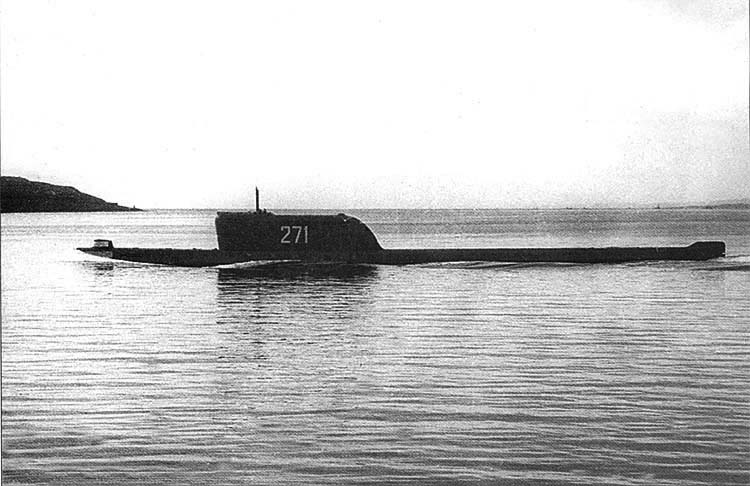
K-16 was laid down on May 5, 1960, launched 07/31/1961, commissioned on December 28, 1961. She made three patrols from 01.1964 to 08.1968 over 126 days, and in 1965 her longer one represented 65-day and 15,850 miles. From 10/4/1968 to 12/28/1970 she was converted in drydock to Project 658M at Zvezdochka Shipyard, Severodvinsk. She returned into active service for seven cruisers from June 8, 1971 to October 1, 1977, 324 days. From 02/10/1982 to 07/20/1985 SALT I saw her ballistic missiles removed and she was converted under Project 658-T, reclassified as multi-purpose submarine. By May 22, 1986, while loading ammunition an incident saw partial flooding of the 1st compartment and she was repaired in 1987 until stricken, transferred in 1988 for recycling disposal and BU.
 K-145
K-145
K-145: was laid down on January 21, 1961, launched 05/30/1962 and commissioned on October 23, 1962. From December 1965 to 1970, she was in overhaul, having her steam generators changed and was reconfigured as a Project 701 test SSBN, from August 1970 to November 1972 she tested the D-9 missile system and entered service as sole of her class, patrolling until put in overhaul from 11.1972 to 12.1976. By 1979-80 she made 2 cruises. On 03–06.1979 her reactor cores were recharged and she was discarded and stricke by 1989.
 K-149
K-149
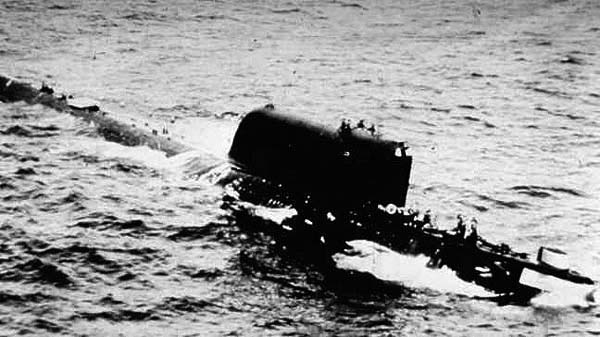
K-149 (from 1969 “UKRAINIAN KOMSOMOLETS”) was laid down on April 12, 1961, launched 07/20/1962 and commissioned on October 27, 1962. By late 1962 she started service and cruisers from 06 august 1963 to 07 may 1964 in the Norwegian Sea fore the exercize “Fence” and from November 1964 to December 1965 she was in drydock fro conversion into the Project 658-M. 1965-69 saw her making four operational cruises over 212 days and between March 1969 and June 1970, she was in overhaul, with replacement of her reactor cores. In 1970-79 she made seven deterrence patrols for 282 days total. On November 25, 1975 she suffered a main power plant incident and the reactor was turned off. On 12/6/1975 there was a drop in pressure in the 1st circuit of one reactor, and she returned to base. On December 21, 1977, the electrical panel of the LB turbogenerator caught fire, she was stranded for 52 hours in stormy weather. On 03/03/1978 another electrical panel fire had one sailore seriously burned. In 1979 under SALT I she lost her missiles and from January 1984 to April 1989 she was converted under Project 658-T but only served until 1991 and was stricken.
 K178
K178
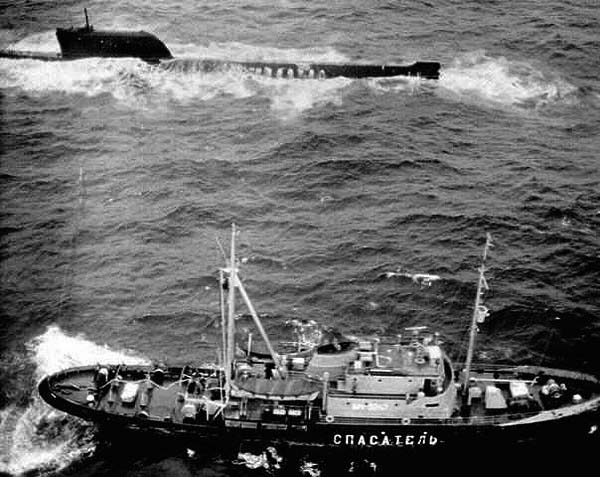
K-178 was laid down on September 11, 1961, launched 04/01/1962, commissioned on December 8, 1962 and by 1963 she started service, then on 09/14–30/1963 she made her first under ice cruise from the Northern Fleet to the Pacific Fleet, over 4411 miles in 374 hours, including submerged 3,460 miles (and under ice 1,617). Both the commander and crew were awarded awards. From 06.1965 to 12.1967 she was upgraded to Project 658-M. in 1968-71 she made 3 cruises over 161 days. From 01.1972 to 04.1974, she was in drydoc for her PrB reactor core replacement. In 1975-76 made 2 combat cruises for 101 days. In December 1975, her reactor compartment was partially flooded by accident and her powerplant was disabled; She was towed to port and repiared from 08.1977 to 04.1978 with full replacement of her LB reactor core and re-equipment as a 658-T boat, reclassified as multi-purpose submarine. From November 3, 1982 to December 31, 1984, she was converted as a Project 658-U communications relay submarine. In 1986, her reactor core was replaced. In 1987, restrictions on operation saw her using polyurethane foam units. On January 25, 1988, a fire at the base during maintenance in compartment VII, killed one sailor. She never ventured out again. In 1990 she was stricken and sold for BU.
Read More/Src
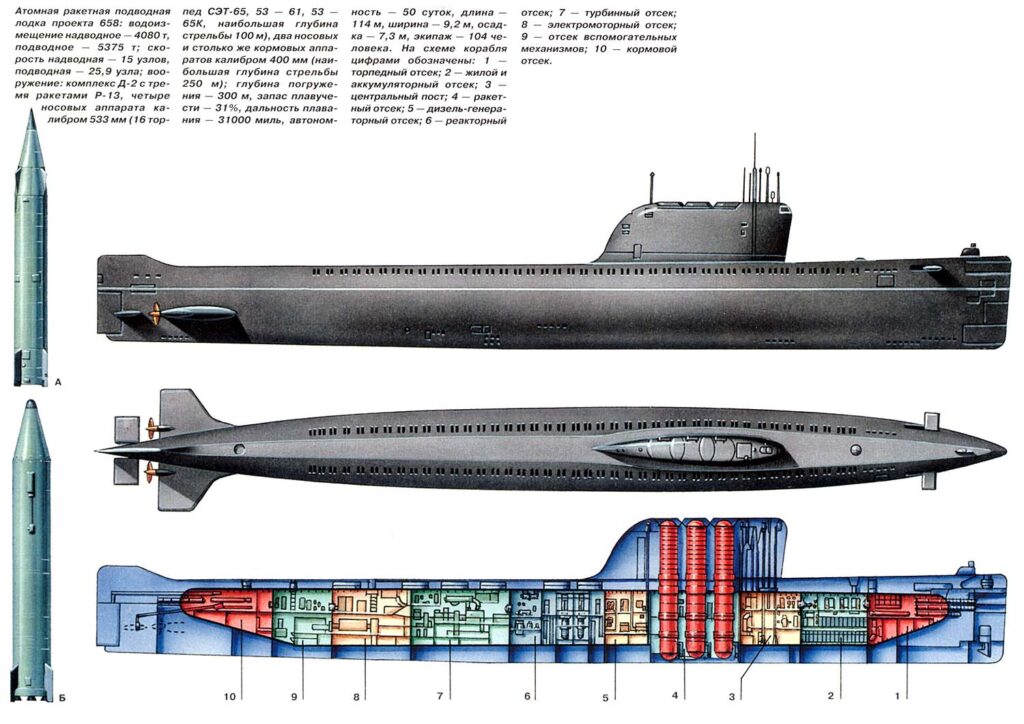
Books
Podvodnye Lodki Rossii, Atomnye Pervoye Pokoleniye; Tom IV, Defense Ministry Scientific-Research Institute & Rubin Central Design Bureau StPeter 1996
Jackson, Robert (2000), Submarines of the World, Friedman/Fairfax Books
John Gardiner’s Conway all the world’s fighting ships 1947-1995
The Encyclopedia Of Warships, From World War Two To The Present Day, General Editor Robert Jackson
Links
nuke.fas.org/
russianships.info/ project_658.htm
spb.org.ru/ 658.htm
militaryfactory.com/
russianships.info/eng/submarines/
ship.bsu.by/
russianforces.org/book/
navypedia.org/ ru_ss_k19.htm
http://russiafile.com/hotel.htm
on ru.wikipedia.org/
arms.ru/nuclear/pr658.htm
on deepstorm.ru/
on atrinaflot.narod.ru/
on arms.ru/nuclear/pr658.htm
on submarine.id.ru/sub.php?658
Videos
none found so far
Model Kits

General query on scalemates
A choice of kits from Flegman, Grigorov and Zvezda in 1:700 and 1:350, especially the K-19.
In popular culture: K-19, the “widowmaker”
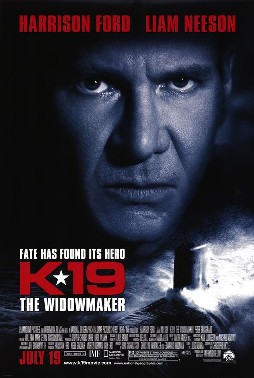
If the “november” class boats already had a poor reputation, the Hotels certainly shared their poor twi reactor arrangement, a rushed first generation which their crews paid dearly. Worst of all was the lead boat of the class, K-19. The revelations after declassified document post-USSR collapsed led to considering her career. She appeared indeed cursed, with most of hew crew sick of radiation poisining after her first cruise, and half her crew did from suffocation after a dramatic fire, and a collision with a Los Angeles sub in between. The story was compelling enough for Hollywood (PARAMOUNT) to distribute a very costly independent film by Kathryn Bigelow on a script from Christopher Kyle and story by Louis Nowra (Mark Doyle). The movie aired on 2002 and critics were lukewarm, it never recoup its initial budget. Despite this, Harrisson Ford estimated this was his best role, well seconded by Liam Neeson. 52 vets from K19 saw the movie in October at its release and globally appreciated it despite it took liberties with facts for dramatization effect, notably the mutiny.



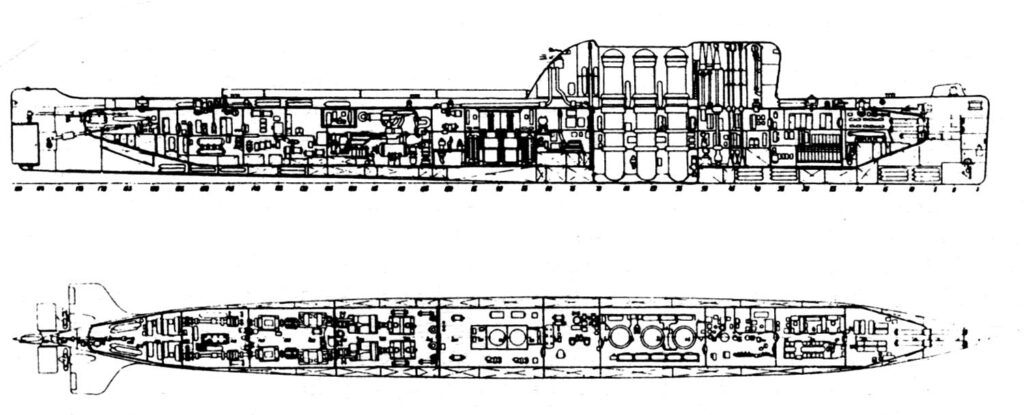

 Latest Facebook Entry -
Latest Facebook Entry -  X(Tweeter) Naval Encyclopedia's deck archive
X(Tweeter) Naval Encyclopedia's deck archive Instagram (@navalencyc)
Instagram (@navalencyc)





 French Navy
French Navy Royal Navy
Royal Navy Russian Navy
Russian Navy Armada Espanola
Armada Espanola Austrian Navy
Austrian Navy K.u.K. Kriegsmarine
K.u.K. Kriegsmarine Dansk Marine
Dansk Marine Nautiko Hellenon
Nautiko Hellenon Koninklije Marine 1870
Koninklije Marine 1870 Marinha do Brasil
Marinha do Brasil Osmanlı Donanması
Osmanlı Donanması Marina Do Peru
Marina Do Peru Marinha do Portugal
Marinha do Portugal Regia Marina 1870
Regia Marina 1870 Nihhon Kaigun 1870
Nihhon Kaigun 1870 Preußische Marine 1870
Preußische Marine 1870 Russkiy Flot 1870
Russkiy Flot 1870 Svenska marinen
Svenska marinen Søværnet
Søværnet Union Navy
Union Navy Confederate Navy
Confederate Navy Armada de Argentina
Armada de Argentina Imperial Chinese Navy
Imperial Chinese Navy Marinha do Portugal
Marinha do Portugal Mexico
Mexico Kaiserliche Marine
Kaiserliche Marine 1898 US Navy
1898 US Navy Sovietskiy Flot
Sovietskiy Flot Royal Canadian Navy
Royal Canadian Navy Royal Australian Navy
Royal Australian Navy RNZN Fleet
RNZN Fleet Chinese Navy 1937
Chinese Navy 1937 Kriegsmarine
Kriegsmarine Chilean Navy
Chilean Navy Danish Navy
Danish Navy Finnish Navy
Finnish Navy Hellenic Navy
Hellenic Navy Polish Navy
Polish Navy Romanian Navy
Romanian Navy Turkish Navy
Turkish Navy Royal Yugoslav Navy
Royal Yugoslav Navy Royal Thai Navy
Royal Thai Navy Minor Navies
Minor Navies Albania
Albania Austria
Austria Belgium
Belgium Columbia
Columbia Costa Rica
Costa Rica Cuba
Cuba Czechoslovakia
Czechoslovakia Dominican Republic
Dominican Republic Haiti
Haiti Hungary
Hungary Honduras
Honduras Estonia
Estonia Iceland
Iceland Eire
Eire Equador
Equador Iran
Iran Iraq
Iraq Latvia
Latvia Liberia
Liberia Lithuania
Lithuania Mandchukuo
Mandchukuo Morocco
Morocco Nicaragua
Nicaragua Persia
Persia San Salvador
San Salvador Sarawak
Sarawak Uruguay
Uruguay Venezuela
Venezuela Zanzibar
Zanzibar Warsaw Pact Navies
Warsaw Pact Navies Bulgaria
Bulgaria Hungary
Hungary

 Bundesmarine
Bundesmarine Dutch Navy
Dutch Navy Hellenic Navy
Hellenic Navy Marina Militare
Marina Militare Yugoslav Navy
Yugoslav Navy Chinese Navy
Chinese Navy Indian Navy
Indian Navy Indonesian Navy
Indonesian Navy JMSDF
JMSDF North Korean Navy
North Korean Navy Pakistani Navy
Pakistani Navy Philippines Navy
Philippines Navy ROKN
ROKN Rep. of Singapore Navy
Rep. of Singapore Navy Taiwanese Navy
Taiwanese Navy IDF Navy
IDF Navy Saudi Navy
Saudi Navy Royal New Zealand Navy
Royal New Zealand Navy Egyptian Navy
Egyptian Navy South African Navy
South African Navy






























 Ukrainian Navy
Ukrainian Navy dbodesign
dbodesign